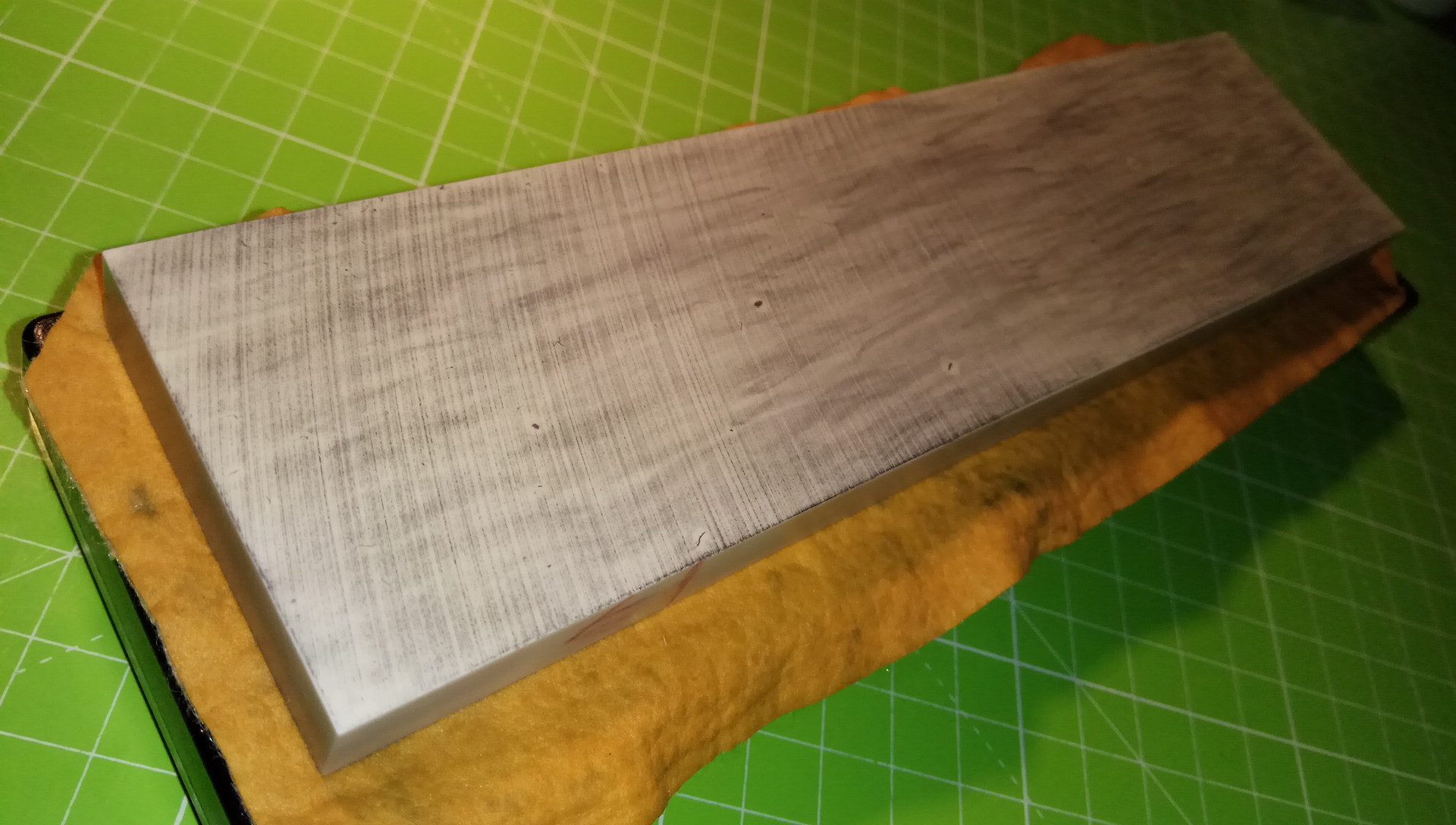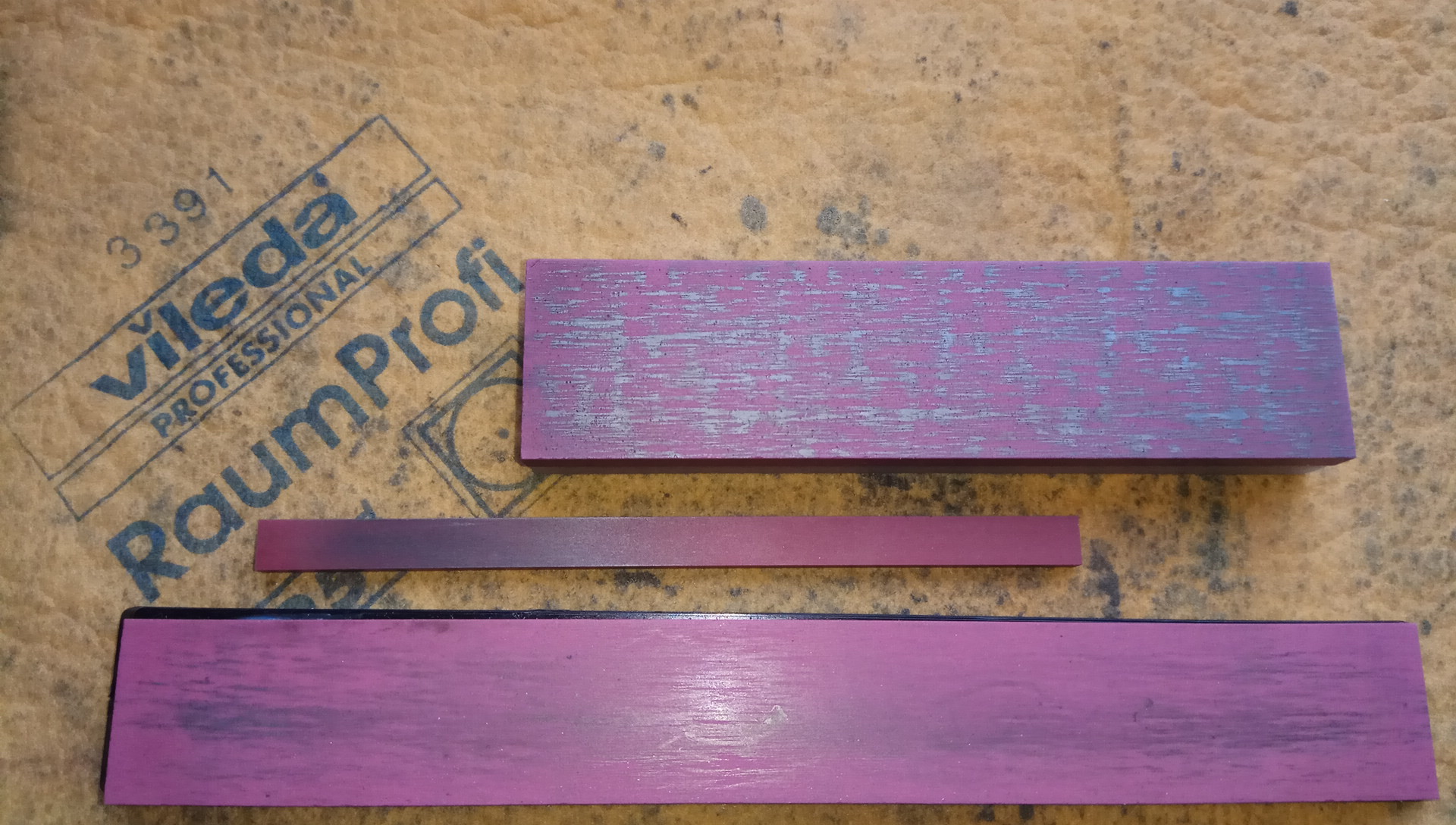DD57 has the following properties (repeating some things already mentioned):
- Really, really hard
- Really, really flat – they’re visually as flat as my Starrett straight edge, that is, no light passes through between the stones and the straight edge, in any direction
- The only thing that matters is the surface finish (medium and fine contain the same mix of 10 and 100 µm “grit”, they’ve just been ground with different diamond wheels)
- Resurfacing can quite easily be done using silicon carbide powder
The ones glued to a wooden box, 90{1,2}-4111{0,1,2}-0, can be removed from the wooden box and have their underside used as well. You’ll have to destroy the wooden box in the process, however, as the glue they’ve used is incredibly strong. I believe that they use stones that have minor imperfections on one side for this product group. The one I did this with had a minor blemish in the spreading of the iron oxide, so a dot, about 1 to 2 mm in diameter is slightly lighter in color on that side. It doesn’t affect performance.
I find the largest stones to be quite nice to sharpen on. The feedback is a lot better than you’d expect. They don’t sharpen very fast, but they’re very consistent and they work well for most any ferrous metal, from low to high hardness. I haven’t tried them with high vanadium carbide steel, but I trust that they would at least work, even though my diamond stones might be more well suited for that use case.
Note that they certainly work for non-ferrous metals as well, but, as with most any material, some amount of Aluminum or Copper will stick to the surface. I’ve found that they don’t really load up with Aluminum or Copper, mostly because they’re so finely ground that there’s really no place for the Aluminum or Copper to go, so it’s mostly aesthetic.
I’ve found it quite hard to quantify what grits they correspond to, but I would venture a guess that I wouldn’t make anyone angry if I stated that the coarse finishes in the FEPA P 600–800 range, the medium in the 1200–1500 range, and the fine in the 2500 range. Given how flat these stones are, they resulting surface is very flat as well. The finish won’t be a mirror, that’s for diamonds, but it will give a mirror-like appearance.
Simpler cleaning can be done using an eraser, preferably one based on natural gum (India rubber). A thorough cleaning can be done using, for example, Barkeeper’s Friend. Barkeeper’s Friend will get most anything off if you let it sit for a while and then scrub well enough.
I haven’t tried resurfacing using diamond powder, though they state that diamond powder can be used to achieve even finer finishes on the stones.
The smaller stones that come in various sizes are quite useful for various tasks, though hardly for sharpening a knife. They can be useful for minor fixes, such as a nicked tip or such.
AL24, used for the coarse variant of the larger stones, is very different from DD57. It’s white in color, slightly porous, consists of 100µm “grit”, and is very different to the touch. It does its job well. Sadly, they don’t make the largest stone – 200×50×12 mm in size – in this material.
The set phrase “your children will inherit it” used so often for products of this kind to justify their cost really does apply here. It’s basically a big jewel that’s both pretty to look at and also quite useful.
Here’s the content of a document called “Instructions for fine grinding tools made of FRIALIT®-DEGUSSIT® oxide ceramics” by Aliaxis, the previous owners of Friatec. I believe they’re now owned by Kyocera Ceramics.
Fine, dense whetstones made of DEGUSSIT DD57 should be moistened with petroleum or cutting oil before use.
Clean with oil after use: using grease solvent, for example petroleum, xylene or similar. if necessary, any acid or alkaline solution can also be used.
For dry applications, the stone will remain clean considerably longer if usage traces are removed at regular intervals.
Regrinding the abrasive surfaces: Grind on a flat iron plate using a lapping emulsion of silicon carbide powder (with the following grain sizes) and water:
Type fine: Grain no. 400
Type medium: Grain no. 80
Type coarse: Grain no. 60
refine or coarsen the surfaces of the fine stones with silicon carbide powder. Use grain no. 180 to coarsen the fine stones. The surface can be considerably enhanced or polished using very fine boron carbide or diamond powder. Use grain size no. 60 to coarsen fine grinding tools of medium type and no. 120 to enhance.
When treating surfaces, ensure that there is enough unused silicon carbide powder on the grinding plate, otherwise its effectiveness will be quickly lost during grinding.
Fine cuts and edges (e.g. knife blades, gouge stones, etc.) can be sharpened or blunted by pulling through another stone in FRIALIT-DEGUSSIT oxide ceramic.
Do not bend thin, fine grinding tools in FRIALIT-DEGUSSIT oxide ceramics.


 :
:













